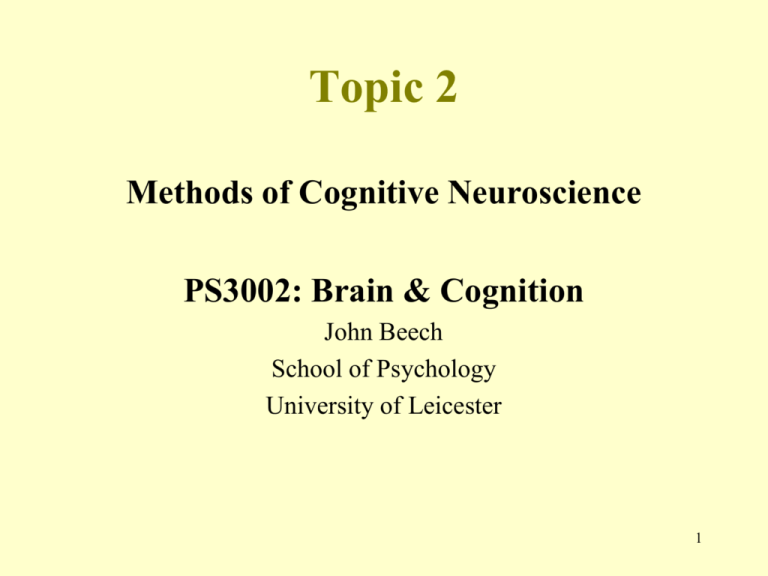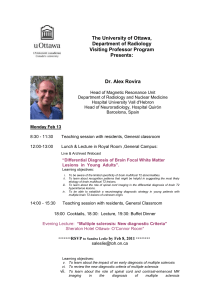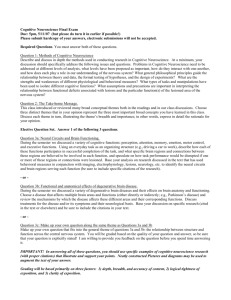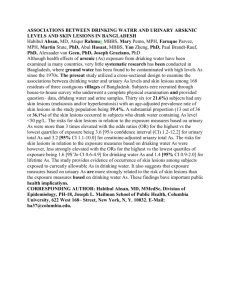Components of memory - University of Leicester
advertisement

Topic 2 Methods of Cognitive Neuroscience PS3002: Brain & Cognition John Beech School of Psychology University of Leicester 1 Topic 2. Methods of Cognitive Neuroscience Cognitive Neuroscience draws on approaches at many levels in trying to explain function with respect to structure • Neurophysiology • Lesion techniques • Structural image methods • Functional image methods (activity) • Cognitive psychology • Computer modelling 2 Electrical brain mapping If people have to undergo surgery for epilepsy, one procedure it to use electrical brain mapping in order to guide surgery. In Stage 1 the surgeon makes an opening in the skull exposing the brain’s surface onto which electrodes are placed. 3 Electrical brain mapping • The scalp is then closed and the patient returns to bed and is closely monitored. This extraoperative brain mapping is done while the patient is awake and conscious. Several days later in Stage 2 the surgeon performs the operation removing the abnormal tissue using this information from the brain map. • Another procedure, usually connected with motor areas takes place intraoperatively – during the operation – in which locations of the brain are stimulated to identify areas of movement, language, sensation or vision. 4 Electrical brain mapping • But the patient needs to be able to actively participate in this and for this purpose is woken from anaesthesia and given enough medication to stop pain. • The risks involved are small and most patients find the process interesting – e.g. their arm can suddenly lift without effort, or a tickle might be felt, or a specific visual image evoked, or they involuntarily start laughing. • But outside the sensory and motor areas the picture is not so clear. The temporal lobes, for example, evoke memories, but the areas are not too consistent. 5 Neurophysiology: Single cell recording • The fluctuating potential during discharge makes it possible in principle to record the firing of a single cell. However this is technically difficult, and impaling the cell may damage it. • Thus more commonly the activity of a small group of neurons in the vicinity of the microelectrode tip is recorded - field potentials. The recording must be made within 100 micrometres* of the neuron. • Computer algorithms can be used to resolve this pooled activity into single neurons. • Baseline activities (rate/frequency of firing) can range from 1 to 100Hz**. • Neuroscientists look at what alters rate (in either direction) • Hence, can record during a task, or as the animal moves around the cage. (*One micrometre = one millionth of a metre. **Hz = standard measure of frequency is Hertz and means “cycles per second”, so 1 Hz means one firing per second and 100 Hz means firing @ 100 times a second.) 6 Neurophysiology: Single cell recording • Virtually all recordings on humans are done in the context of operations for epilepsy. • Can record from visual cortex; firing correlates with only a subset of visual stimuli having particular properties of place, shape, colour or movement. • Retinotopic maps. When an object produces an image on the retina, it similarly activates higher retinotopic areas in the brain, keeping the object’s shape. This image mapping is 'retinotopic mapping‘. This is a point-for-point copy of the topography of the retina. But the “brain image” activation doesn’t “look like” the original object. 7 Neurophysiology: Single cell recording Similarly in the somatosensory cortex there is a topographical map. The figure on the right shows how parts of the body are mapped in the somatosensory cortex. It can be see that these body maps are quite orderly, although there is no obvious reason why they exist in precisely this way. 8 Neurophysiology: Single cell recording • Tonotopic (i.e. cochleotopic) maps can be found for the auditory system.This means that the acoustic frequencies in the auditory cortex are mapped with a similar topology in an associative area of the brain. • Often there are responses in multiple brain areas. This raises the question of which is primary. Is one driving the other? Accurate timing of the responses may help to establish this. As an example consider the relationship between the cerebellum and the motor cortex… 9 • Patients with damaged cerebellums (CBs) have balance problems like someone who’s drunk. Alcohol depresses cerebellum activity. • The CB first gets information about intended movement from the sensory and motor cortexes. Then the CB returns information to the motor cortex about direction, force and duration of the movement. Neurophysiology: Single cell recording • Cells in the motor cortex and the cerebellum (CB) are reciprocally, but indirectly, connected. They are activated prior to a movement, but which comes first? 10 • In fact (cf Thach, 1975) cells in the lateral (side of) CB fire before those in the motor cortex, and thus are likely to be involved in movement planning. • Cells in the intermediate CB region fire after those in the motor cortex, and thus are likely to be involved in ongoing movement. • This approach can be extended to simultaneous recordings of many cell groups - Wilson and McNaughton recorded simultaneously from 150 cells in the rat’s hippocampus. Neurophysiology: Single cell recording 11 Lesion techniques • Much information has come from the study of the effects of lesions. However, caution is needed in attributing causal explanations. • For human studies we are limited to studying naturally occurring lesions (although lesions are also induced surgically or chemically as part of a treatment). • In animals we may also study the effects of induced lesions. Much of this animal work in the past has involved physical removal of (usually small) parts of the brain. 12 Lesion techniques • This can be made more local by using the passage of current at an electrode tip, producing a very small sphere of damage. • However such lesions are non-selective in type. • More selective lesions can be induced by local injections of drugs or chemicals such as kainic acid. • Chemically selective lesions may also result from self-administration of drugs in humans. • That is how MPTP, which selectively lesions dopamine neurons, was discovered - as a contaminant in synthetic heroin. MPTP mimics the same neurological damage that afflicts those with Parkinson’s Disease. 13 Lesion techniques • A student, Barry Kidston, in 1976 mistakenly manufactured MPTP thinking it was something else and within 3 days of taking it had severe Parkinsonian symptoms. About 2 years on he committed suicide and postmortem showed neural damage in the substantia nigra – the same as found in Parkinsons patients. • MPTP has since been useful in animal research to simulate the effects of Parkinson's Disease and hence search for a cure (e.g. by stem cells). • “Ecstasy” 3,4-methylenedioxymethamphetamine (MDMA) also induces chemically selective lesions in serotonergic* systems in animals, which have behavioural effects. These lesions appear to be permanent according to much animal work (e.g. Fischer et al. 1995), but others dispute this. * (capable of liberating serotonin, esp. in transmitting nerve impulses) 14 Lesion techniques • Thus “rave culture” is actually a massive natural human experiment. • Transient, reversible, functional lesions can be induced by local injection either of antagonists*, or of local anaesthetics, which will wear off, or by local cooling, which can also be reversed. [ON - OFF - ON states] *(Antagonist – a chemical substance that interferes with the physiological action of another, esp by combining with and blocking its nerve receptor.) 15 Natural lesions - the Neurological approach • As noted before, neurologists have often been interested in the behavioural effects of particular lesions, whatever their source. • There has been an increase in the use of in-depth psychological testing of neurological patients. • There is a wide variety of causes of neurological disorders: - vascular*(strokes); tumour; degenerative (may be genetic) and infectious (e.g. viral) - trauma (wounds) *(Vascular = relating to mainly blood vessels.) 16 Natural lesions: Neurological approach This interest in neuropsychology springs from three sources: 1. from the increasing sophistication of psychological testing; 2. from the rapid development of in vivo* tools for the accurate localisation and assessment of brain lesions; 3. because these changes enable us to learn from the study of small groups, or even of individual patients, rather than requiring large groups, who are often heterogeneous. One case can be enough to show it can happen, and the methods show the detail. *(in vivo = in the living organism.) 17 In vivo tools: Structural imaging Functional neurosurgery: can look at functional consequences of surgery (often needed to treat intractable epilepsy) – can involve the removal of a lobe, or produce a functionally split brain, removal of the hippocampus, etc. Principles of CAT or CT (Computerized axial tomography): Tomography in which computer analysis of a series of cross-sectional scans. These are made along a single axis of a bodily structure or tissue and is used to construct a 3D image of that structure. The technique is used in diagnostic studies of internal bodily structures, as in the detection of tumours or brain aneurysms. It relies on X-rays. 18 In vivo tools: Structural imaging Principles of MRI (Magnetic resonance imaging) • This involves the use of a nuclear magnetic resonance spectrometer to produce electronic images of specific atoms and molecular structures in solids, esp. human cells, tissues and organs. It goes into magnificent detail. Thus it uses magnetism and radio waves and doesn’t involve any Xray radiation. • Scanning also important in the evaluation of surgery, and in relation to transplants. • Scanning is painless – apart perhaps from the claustrophobic sensation that can occur. 19 MRI 20 How does an MRI scan differ from a CT scan? In an MRI one can take pictures from any angle, but a CT only takes pictures horizontally. As mentioned, there are no X rays involved with producing an MRI. MRIs are usually more detailed as well. The differences between abnormal and normal tissues are often clearer in an MRI. 21 Imaging magnetic activity of the brain. Functional imaging Magnetoencephalography (MEG) also useful – it detects magnetic variations due to currents in the brain. Limited to fields parallel to skull surface, but yields more information on localisation than EEG ERP 22 PET (positron emission tomography) depends on localising the source of emissions from positrons - i.e. inject a compound labelled with an unstable isotope*, and monitor the arrival of that compound in the brain, and its subsequent decline. PET measures the changes in blood flow associated with brain function. (To explain the 3 terms on the right, imagine a horizontal section – this is AXIAL, note the white cross – the vertical bar of the cross corresponds to the SAGITTAL plane – a vertical longitudinal plane separating into left and right halves – and the CORONAL plane corresponds to the horizontal bar of the cross separating “ear-to-ear” into front and back.) Functional imaging: PET *(isotope = radioactive form of an element.) 23 Functional imaging of the brain • This radioactive compound can be a drug which binds to particular receptors, so we can see the distribution of these receptors; also can indicate the displacement from these receptors. • It can be labelled water, or Xenon (Xe), an inert gas, or a heavy isotope* of oxygen gas. • These give measures of local blood flow, which is useful to know, given that increased local metabolic activity of the brain is accompanied by increased local blood flow. *(isotope = radioactive form of an element.) 24 Functional imaging of the brain Thus besides looking at the difference between something and nothing (visual fixation +/stimulus) we can compare with more sophisticated controls (shadowing words vs creating a word association). fMRI enables us to make the same sort of measurements - uses variation in the signal due to differences in the haemoglobin signal reflecting increased oxygenation of blood in metabolically more active areas. 25 Functional imaging: fMRI • A volunteer preparing for an fMRI study on face recognition • fMRI unlike PET, doesn’t need radioactive materials and produces a higher resolution image. • This involves a giant magnet around the head that induces hydrogen atoms in the brain to give out radio signals. These increase when the blood oxygen increases, showing which areas are most active. • Hundreds of scans can be done as the method is not invasive and it yields very detailed information. 26 Functional imaging of the brain • Can detect decreases, as well as increases, from baseline or control, in blood flow. • Although spatial resolution is limited due to speed of sampling required, can project results onto a detailed structural picture obtained in the same session. • There are individual differences in size and shape of the brain, and of local areas, but this can be compensated by “normalising” the image to a “standard” brain. This can be done within the processing that the computer is doing anyway. • Trade-off of time resolution and spatial resolution. 27 Imaging electrical activity of the brain: the electroencephalograph (EEG) • The bonnet contains electrodes that are “hooked” to the scalp and these sense impulses from the brain. • The picture below illustrates the recorded data. 28 Imaging electrical activity of the brain • Instead of looking at “damaged” brains, we can correlate activity in the healthy brain with mental processes. • EEG - global – evoked potentials -- signal averaging -- sensory processing deficits • In the cortex, it tells you when not where. • Problem of localising the generators (sources). Can predict surface from generators, but not vice versa, especially if you don’t know how many generators there are. 29 ERPs (event-related potentials) An example of use The ERP is produced by averaging signals/traces from the EEG over say 100 trials, which reflect neural activity associated with a cognitive event. In the example on the right responses to standard and deviant sounds are recorded. P1 effects usually occur about 100 ms after a stimulus, this is followed rapidly by an N1 effect. (The upper part of the signal represents the negative part, hence “N1”, whereas the lower area is the positive part, hence “P1”.) 30 Cognitive psychology • Concerns mental representations and transformation. - Giving some illustrative examples here. • Object sensation perception memory action. • Not simply a linear sequence because memory influences perception. • For some time there have been efforts to identify areas of brain for each type of process. 31 The Posner task • Posner (1978) presented two letters together (e.g. AA) and people had to say if they were “same” or “different”. RTs varied according to the type of categorisation. For example AA vs AB involves simple pattern matching; but if you are required to respond that Aa has the same letter sound as AA (vs Ab is different), you have to check that both letters have the same sound /a/ (as in “cake”). 32 The Posner task • If the stimuli (e.g. Aa) are presented successively (i.e. A followed by a), with a variable delay, the longer the delay, the less difference there is between the physically identical, and phonetically identical, cases. • This is because processing has been going on meanwhile. • Hence by appropriate manipulations we can find out about categorisation of stimuli. 33 The Posner task • As an illustration of the use of the technique, consider Barraclough & Beech (1995) used the Posner task to look at the effects of caffeine comparing these two different levels of processing (AA vs Aa) within the left and right hemispheres. • Under conditions without caffeine we found that patternmatching was faster in the right hemisphere and phonological processing in the left hemisphere. However, under the influence of caffeine there was a reversal in this pattern. • This is an example of the use of a cognitive task to examine underlying biological processes. 34 Saul Sternberg Saul Sternberg’s classic experiments (1966-9): Ss shown series of numbers, each for 1.2 s. E.g. given 9 3 5 6 2 and then they were given probe no. (e.g. 5) and had to say if present in the set of numbers in their STM. Each trial gave them a new set with a different size of 1-6 items. See fig for results. 35 Sternberg • Sternberg found that RT increased with set size. Processing rate was 38 msec/item. Also no difference in slope for the ‘yes’ or ‘no’ items. • Strange result as suggested scanning is serial and exhaustive rather than selfterminating. 36 Sternberg • One would expect that when a “Yes” required that when found S would immediately make a response. If this had happened the slope would have been half that for the “N” responses. For the “N” responses, all items would have to be scanned. • But this is not what Sternberg got. He could conclude that scanning STS is serial and that it is exhaustive. 37 Stroop effect (review in McLeod, 1991). • Task: report the ink colour of words: blue red green • Delay when those words are actually the names of other colours (e.g. green). The effect is more marked for a verbal response (name each word – “green”), than for a key-press. (Is the colour of the word congruent/incongruent with the colour it represents? In this case the “incongruent” key pressed.) • Representation of the colour (hue) associated with reading the word is also activated so that it interferes. • Stroop effect is not reduced by a concurrent task judging pitch, but is reduced by a concurrent task monitoring a word list for targets, i.e. this interferes with the verbal encoding of the colour name. 38 Computer modelling • A model or theory must be explicit with respect to its operations, although the outcome may not be known beforehand. • Altering connectivity can alter behaviour directly; it does not necessarily imply that the system has a representation, or an “understanding” of the situation • Beware anthropomorphism – saying a machine “is attracted to the light” or “avoids the light” • Problem of the homunculus – the conscious being who sits inside the machine – may return in disguise as the internal executive controller, or the supervisory attentional system. 39 • Representations - input and output layers - hidden units. • Look like neuronal arrays (although the elements are much less complicated in function than neurons) • Show graceful degradation • Can examine the effects of “lesions”, e.g. pruning (selective or random) of the network, and compare with what is seen in human pathology. • Testable predictions can be generated. Computer modelling 40 Computer modelling Connectionist modellers have had a number of criticisms: • There is not much testing of one model against another – usually testing is sufficient only to establish that a model can account for this, rather than that the brain does actually do it this way. • Related to this, in neuroscience a major endeavour is to theorise about how neurons or collections of neurons operate. These theories are then tested. But it does not appear that these findings are presently used in any way by connectionists. There is a big gap between connectionist networks and real neural nets. • There is sometimes the idea that if a theory can be simulated, then this means that the theory is consistent. But this does not follow as the modelling itself may in its deeper areas be acting inconsistently. • Another problem is that connectionist models can simulate virtually anything; so they don’t really get us any further about choosing between alternatives. • Finally, characteristically the descriptions of these models are too fuzzy to get a meaningful conception of what is going on. 41 Converging methods • When examining cognitive deficit and brain damage – the clinician/experimenter analyses how behaviour is changed, using multiple tasks, rather than loss of single function (e.g. reading requires the interaction of many components) • Many areas interact. Better to use more refined testing with contrasting conditions, to probe for single deficits • Double dissociation important because it eliminates possibility that one task is harder than the other… 42 Converging methods: single and double dissociations Tasks (% correct) Group Recency memory Single dissociation Temporal lobe damage 90 Controls 90 Double dissociation Temporal lobe 90 Frontal lobe 60 Controls 90 Familiarity memory 70 95 70 95 95 43 Converging methods: single and double dissociations • The previous table is a hypothetical example (from Gazzaniga et al.) in which two types of memory are distinguishable – recency memory concerned with us knowing how long ago we learned something and familiarity memory – concerned with how familiar a piece of information is. • In single dissociation the temporal lobe damage group show problems only in familiarity memory. • Whereas in double dissociation one patient group is impaired in one type of memory while the other group is impaired only in the other type of memory. 44 Converging methods • Merits of group versus individual studies. • Examining individual cases has a strong tradition in the fields of learning/conditioning and in neuropsychology. • Inevitably it is good to have confirmation within a group studied together, but individuals vary in the precise localisation of their lesions. • However, reconstruction software allows determination of degrees of overlap across a group from imaging data. 45 Conclusion • This was an overview of methods used in cognitive neuroscience, which as you can see covers most of the methods used in neuroscience itself. • The aim is to give you background, so that you will have some familiarity with these methods. • These methods, often in varying combinations, are used to look at specific cognitive functions, in order to build up a more integrated understanding of cognitive brain function. 46





